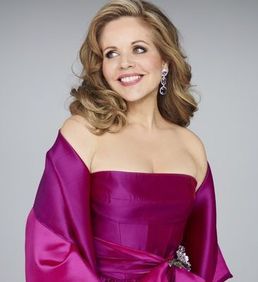 Soprano Renée Fleming.
Soprano Renée Fleming. At 56, Fleming still sounds (and looks) absolutely fabulous. And while RTH isn’t, frankly, an ideal place for a vocal recital, on Friday night she seemed entirely at home on the cavernous stage – with nothing but a grand piano, played by Gerald Martin Moore.
Much to her credit, she didn’t do what some singers I’ve heard at RTH (or similarly oversized venues) do: shriek and bellow at the back wall. While Fleming possesses a voice that’s entirely big enough for such purposes, she took a more intelligent approach. This was, after all, an art-song recital, and Fleming treated it as such, creating an illusion of intimacy. While this may have made people up in the second balcony wish they had bought more expensive seats, it made everyone in the hall listen more closely and attentively. Fleming made us better listeners, and we were richly rewarded for the effort.
Fleming’s set of four songs by Rachmaninoff was cobbled together from several cycles: Op. 4 No. 3, Op. 8 No. 1, Op. 4. No. 4 and Op. 14 No 11. Here, Fleming took a more full-bodied vocal approach, nicely matching the composer’s lush piano textures. This was glamorous, elegant singing, and Fleming’s phrases soared expressively. I particularly enjoyed “Vesenniye vodï” (“Spring Waters”), which Fleming made into an outburst of pure joy.
Similarly, Fleming assembled a set of thee Richard Strauss songs from various sources. “Das Büchlein” was a flurry of activity. The sparse-textured “Ruhe, meine Seele!” was sung with admirable restraint. And “Allerseelen” was autumnal and comforting.
Three of the Songs of the Auvergne, by Canteloube, were excellent vehicles for the sheer beauty of Fleming’s tone. Her “Baïlèro,” in particular, was clean, clear and utterly gorgeous; this one song alone was worth the price of admission. “Malurous qu’o un fenno” sparkled delightfully, and “Brezairola” offered even more vocal gorgeousness.
It seems that Fleming wanted something new and different as a conclusion to her program. Nothing wrong with that – but I can’t say I shared her apparent enthusiasm for the five songs by the jazz singer Patricia Barber that she chose (entitled “Higher,” “Scream,” “Hunger,” “Morpheus” and “You Gotta Go Home”). Nor can I say that either Fleming or Moore fully embraced the jazzy qualities of this repertoire. Also, despite Fleming’s best attempts at getting the words out into the hall, the songs made a strong case for the need to print the texts of English-language songs in the program book. It would have been nice to know what Fleming was singing about.
Some people say that the song recital is dead or dying. And it may be true that not every singing Tom, Dick or Harriet can draw an audience these days. But as long as Fleming and a few other artists of her stature are prepared to tour with superb programs of art songs, the genre will survive.
© 2015 Colin Eatock
 RSS Feed
RSS Feed

